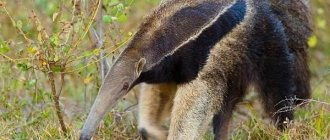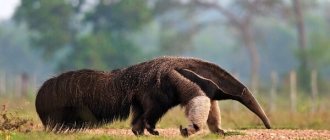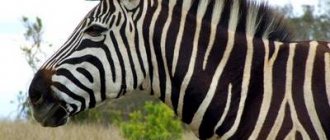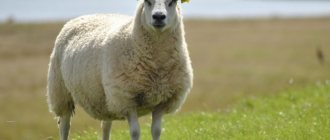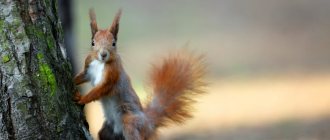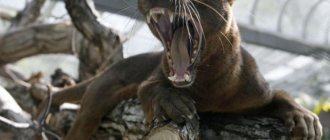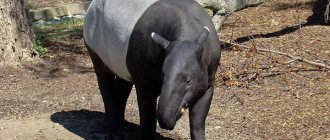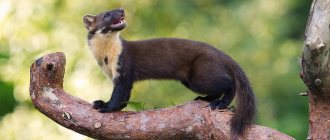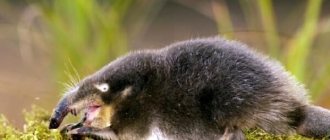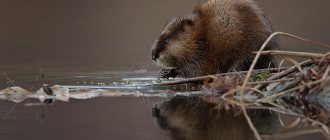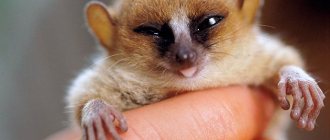- Where does the anteater live?
Anteaters are perhaps one of the most amazing mammals on our planet; thanks to their more than unusual appearance, they have gained wide fame among lovers of exotic animals. And the first person who had his own pet anteater was the great and eccentric artist Salvador Dali; it is quite possible that the appearance of this animal inspired him to paint his unusual paintings. As for anteaters, they belong to the order of edentates; their distant relatives are armadillos and
sloths (although they are not at all similar in appearance), there are three species of anteaters themselves, in natural conditions they live exclusively on the American continent, but read on for more details about all this.
Description, structure, characteristics
The sizes of anteaters vary depending on the species, so the largest giant anteater reaches two meters in length, and what is interesting is that half of its size is in the tail. Its weight is approximately 30-35 kg.
The smallest dwarf anteater is only 16-20 cm in length and weighs no more than 400 grams.
The anteater's head is small, but very elongated, and its length can be 30% of the length of its body. The anteater's jaws are practically fused together, so it is impossible for him to open his mouth wide, however, he does not need to do this. Like having teeth. Yes, anteaters literally have no teeth at all, but the lack of teeth is more than compensated for by the anteater’s long and muscular tongue, which stretches along the entire length of their muzzle and is a real source of pride for this animal. The length of the giant anteater's tongue reaches 60 cm, this is the longest tongue among all living creatures living on Earth.
The eyes and ears of anteaters are not large, but their paws are strong, muscular, and also armed with long and curved claws. These very claws are the only detail of their appearance that reminds of their relationship with sloths and armadillos. Anteaters also have a well-developed charm and can smell potential prey.
Anteaters also have rather long and, moreover, muscular tails, which have a useful application - with their help, anteaters can move through trees.
The giant anteater has long fur, especially on its tail, which gives it a broom-like appearance. But in other species of anteaters, the fur, on the contrary, is short and stiff.
Save Status
Giant anteaters are widespread from Honduras to northern Argentina, making them unlikely to become extinct in the near future. The main threat to this species is habitat loss . Since three-toed anteaters live in grasslands, fires pose a great danger to them, especially the deliberate burning of sugar cane plantations before harvesting.
Domestic dogs, collisions with vehicles on the highway, sport hunting and hunting for food all also negatively affect the populations of great anteaters. Add to this a very specific diet, low reproductive rates, slowness and sensitivity to climate change, and you get a " vulnerable species " on the IUCN Red List.
There is also concern about the gene pool of three-toed anteaters, the preservation of which could be ensured by protected corridors connecting fragmented populations of animals.
Habitats
Like their other relatives from the order of edentates, anteaters live exclusively in Central and South America, especially many of them live in Paraguay, Uruguay, Argentina, and Brazil. The northern border of their habitat lies in Mexico. Anteaters are heat-loving animals and, accordingly, live exclusively in places with a warm climate. They like to settle in forests (all anteaters, with the exception of the giant one, easily climb trees) and grassy plains, where many insects live - their potential food.
Mexican tamandua (Tamandua mexicana)
The body length of the animal is about 77 cm, the tail is from 40 to 67 cm in length. The muzzle is elongated, curved, the mouth is small, the tongue reaches 40 cm in length. The back has pronounced dark longitudinal stripes that expand towards the shoulders and cover the front legs, like a vest .
The rest of the body is light, from white to brown. The anal gland of the Mexican tamandua secretes a secretion with an unpleasant odor, which is why the animal is called the “forest stink.” The species' habitat includes Central America to southeastern Mexico, South America west of the Andes from Venezuela to northern Peru.
Nutrition
As you can guess from the name of this animal, the favorite food of anteaters is, of course, ants, as well as termites. But they are not averse to feasting on other insects, but only small ones, but there is no need to be afraid of large anteater insects, they simply do not eat them. The point here is that anteaters have no teeth; as a result, they swallow their prey whole, and in their stomach it is digested by gastric juice. And since the food of anteaters is small, and the size, on the contrary, is not so small to feed themselves, they devote all their time to searching for something to eat. Like living vacuum cleaners, they roam the jungle, constantly sniffing out and sucking in everything edible. If on the way of an anteater he suddenly encounters an anthill or a termite mound, then a real holiday and a feast for the whole world begins for him (only for ants or termites such a meeting turns into a real disaster).
In the process of absorbing food, the anteater's tongue moves at an incredible speed - up to 160 times per minute. Prey sticks to it thanks to sticky saliva.
Anteater as a pet
This animal is so interesting that many lovers of the unusual keep it at home. As a rule, tamanduas are started. Anteaters are very smart animals, their owners manage to teach their pets some commands, they even manage to open the refrigerator themselves.
And, of course, you shouldn’t upset them at all, otherwise the pet will be forced to defend itself. To prevent his claws from being so dangerous, it is recommended to trim them twice a week.
Keeping this animal is quite troublesome: it needs to be equipped with a special enclosure, it is better if various ropes, hammocks, and swings are stretched there. It should be remembered that this is a sissy, so the temperature should be +25 degrees. In captivity, anteaters readily eat vegetables, fruits, cheese, and ground foods with the addition of minced meat. Sweets are bad for them.
It is known that Salvador Dali, after reading Andre Breton’s poem “After the Giant Anteater,” became so interested in the anteater that he even kept one in his home.
He walked him on the streets of Paris on a golden leash and even went with his pet to social events. Dali considered the anteater a romantic animal. Anteaters are extraordinary animals. It is very sad that their numbers are only decreasing every year.
Enemies in nature
However, anteaters themselves, in turn, can also become prey for other dangerous predators, especially jaguars,
panthers of large boas. True, to protect against the latter, anteaters have a significant argument - muscular paws with claws. In case of danger, the anteater falls on its back and begins to swing all four paws in all directions. No matter how funny and clumsy such a spectacle may look, in such a position the anteater can inflict serious wounds on its potential offender.
№10
They lead a solitary lifestyle and are found in pairs in the wild only during the mating season. Also, anteaters can meet not alone when the mother is accompanied by her child. Otherwise, they are solitary and very territorial animals. And if the territories of females can sometimes overlap without any consequences, then males do not tolerate other males on their territory.
Types, photos and names
As we wrote at the beginning, there are three types of anteaters in nature, and further we will write about each of them.
Giant anteater
The largest representative of the anteater family, living in South and Central America and also the only one of this family that, due to its large size, is unable to climb trees. Leads a predominantly nocturnal lifestyle; when walking, it characteristically bends its legs, resting on the back of the forelimbs. A means of protection against predators are sharp claws on powerful paws.
Pygmy anteater
On the contrary, it is the smallest anteater living in the tropical forests of South America. The pygmy anteater can climb trees very well; moreover, trees are a safe refuge for it from predators. Like other anteaters, it feeds on small insects, ants, termites, and is nocturnal.
Tamandua anteater
He is also a four-toed anteater, lives in Central America, and there are also especially many of them in southern Mexico. It is relatively small in size, larger than the dwarf anteater, but much smaller than the giant one, its body length is up to 88 cm, weight - 4-5 kg. Just like its dwarf relative, tamandua climbs trees well; according to the observations of Venezuelan zoologists, it spends from 13 to 64% of its life in trees. He has poor eyesight, but has excellent charm, and uses his sense of smell to find his favorite prey, ants and termites.
Interesting fact: the Amazon Indians long ago domesticated the tamandua anteaters, which have been used since ancient times to fight ants and termites in their homes.
What does it eat?
Absolutely all subspecies of anteater have a diet consisting of termites (the most favorite food for anteaters) and ants. But other small insects can also enter the diet.
The anteater has an exceptional sense of smell, with the help of which it tracks down a colony of insects. Once an anteater attacks a termite trail, it follows them all the way to the termite mound. After which it breaks the walls with powerful claws and uses its sticky and incredibly long tongue. Defending termite soldiers attack the anteater with their secretions, which forces it to retreat and, with the help of its amazing sense of smell, find the wall behind which the main population is hiding and continues its feast.
Anteaters never completely exterminate a colony, leaving about a third to restore the population.
Reproduction
Anteaters mate twice a year: in spring and autumn. Pregnancy lasts from three months to six months, depending on the species, after which a completely naked little anteater is born, which, however, is already able to independently climb onto its mother’s back.
Interesting fact: anteater dads also take an active part in raising their babies, carrying them on their backs together with their mother.
Up to a month of life, little anteaters move exclusively on the backs of their parents and only then begin to take their first independent steps.
Feeding baby anteaters may not seem like a very pleasant sight to us; mom and dad anteaters regurgitate a special mass of semi-digested insects, which serves as food for the growing little anteaters.
№8
They adapted to their environment by lowering their body temperature. On average, the body temperature of anteaters is around 32.7 degrees Celsius. This is much lower than that of other placental mammals.
This low body temperature allows the animal to conserve energy while it is resting, since the body only warms up when it becomes active.
This is very important as their diet does not allow them to store large amounts of energy.
Interesting Facts
cats and dogs and even love to play with children. True, keeping an anteater at home is not so easy, because they cannot stand the cold at all; the favorable temperature for them should be no lower than 24-26 C.
Social structure
The giant anteater is generally solitary , except during the breeding season or when females are caring for their young. They do not build permanent nests or resting places, but simply wander around their personal territories.
Average home range ranges can vary from 2.7 to 11.9 square meters. km . The overlap of individual territories is significant, the density reaches up to 2 animals per 1 square. km. Higher densities in certain areas are associated with abundant resources and a lack of natural predators (primarily jaguars), human hunting, and road deaths.
Many females, and to a lesser extent males, will return to their natal areas during the breeding season.
Antagonistic interactions between males are often observed, ranging from circling to serious fighting, indicating that giant anteaters are territorial . Tree scratching may be used by greater anteaters to communicate with members of their own species, or may be caused by stress due to human disturbances or fires.
Video
And in conclusion, for you, a funny video about anteaters, called “10 reasons to get an anteater.”
Author: Pavel Chaika, editor-in-chief of Poznavaika magazine
When writing the article, I tried to make it as interesting, useful and high-quality as possible. I would be grateful for any feedback and constructive criticism in the form of comments on the article. You can also write your wish/question/suggestion to my email [email protected] or Facebook, with respect, the author.
Author page
This article is available in English - Anteater.
№12
Do you think only cats sleep most of their lives? No, anteaters are still dormouse. They sleep about 15 hours a day and spend the remaining 9 hours searching for food. However, it is worth noting that their sleep cannot be called sound. The animal wakes up from any rustle. Such sensitive sleep is necessary for the mammal in order to wake up when danger arises and protect itself from predators.
We also recommend reading: Interesting facts about chimpanzees
